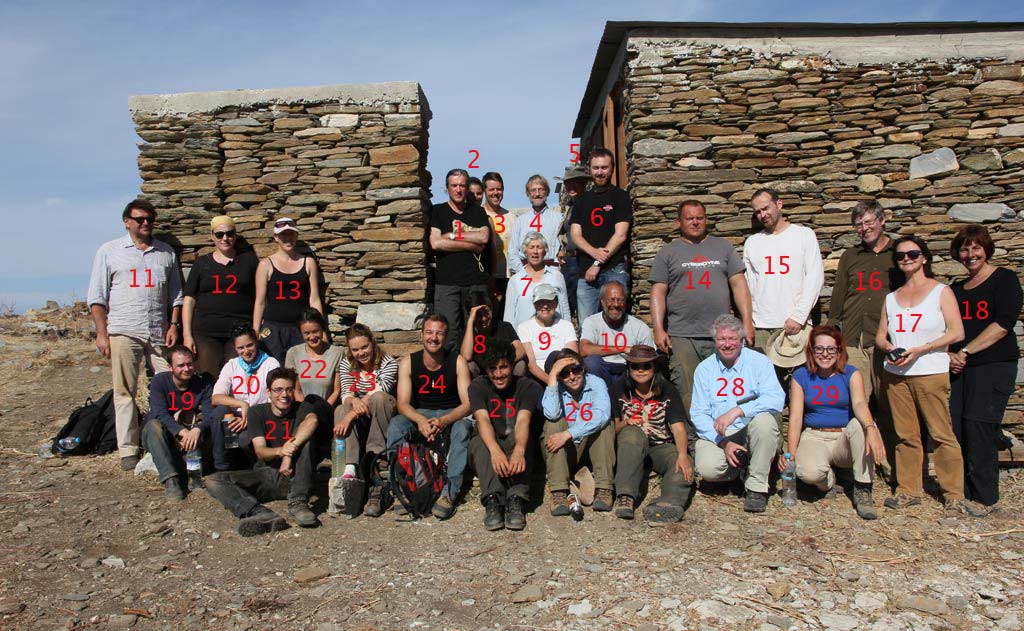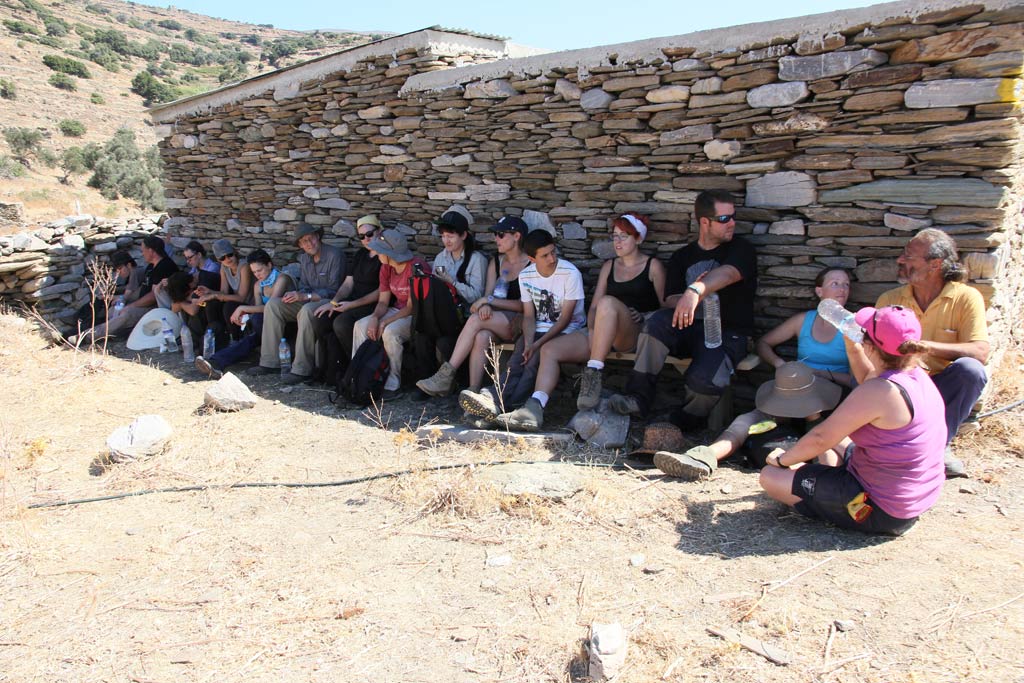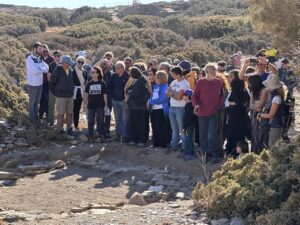by Irma Havlicek
Powerhouse Museum Web Producer
Around Saturday 12 October 2013, we sadly farewell some Zagora team members. The whole team has worked incredibly hard in often challenging conditions, and has done so with great spirit, humour and gusto. We are sure those who are leaving us are a hard act to match – yet we expect those who are arriving this weekend to do so, and look forward to welcoming them. The photo below shows those team members who were on site on Thursday 10 October 2013.

I have numbered and named them in the following photograph so you can tell who everyone is.

On the Zagora 2013 archaeological season, people generally work the whole season of six weeks, or the first three weeks or the second three weeks. There are exceptions where specialists come for different periods at different times, depending on the work required and their availability – for example, Dr Adela Sobotkova and Petra Janouchova, our satellite imaging specialists, and Dr Evi Margaritis, our seeds specialist who set up the wet sieving apparatus.
Not present the day the group photo was taken were Dr Stavros Paspalas, one of the directors of the project and Beatrice McLoughlin who, with Stavros, manages the finds processing undertaken at the Andros Archaeological Museum in Chora. Also not in the photo for various reasons are Sue Jorgenson, Dr Nicola Harrington, Richard Anderson, Lea Alexopoulos, Marco Schugk, Lydia Beaumont-Cankaya, Anastasia Miller-Csapo or Matthew Miller-Csapo. Where they are already pictured elsewhere in the blog, I have linked their names to other posts which include photographs of them.
Here are photos of those who have not yet been pictured on the blog:


And here is a shot of some of the team members having lunch (sitting against the dig hut in the narrow band of shade) on Wednesday 25 September 2013.

*I didn’t have a tripod this day, so both Lesley Beaumont and I took photos of the team. I p myself into this photo from the photo that Lesley took.


8 thoughts on “2013 Zagora team members (weeks 1-3)”
21 = Marco Schugk 🙂
Did you have a birthday? If so – happy birthday! Hope you made it home safely, with rich memories of your time at Batsi and Zagora.
Lovely pictures of people all covered in dust working hard.I do like the picture of the red shirted dust bunny.Ah the joys of working in such an environment.Who built the huts? I like how they constructed the walls.Very different.I liked the hat parade.Very nice photo’s!
I’m glad you’re enjoying the blog and the photos. It is a joy working in such an environment though it can be challenging in the extreme in hot sun or fierce wind. But part of the joy is, I guess, meeting and overcoming the challenges and still getting a formidable amount of work done.
The dig hut (around which we usually have lunch) was built by the first Australian Zagora archaeological research team in the 1960s/70s, headed by Professor Alexander Cambitoglou. They contracted local workmen to build it. The other huts (one in, others around Zagora) have been built by locals either as shelter if they need to stay overnight or as animal pens. I’ve seen no evidence of those close to Zagora being used recently.
Glad you liked the pictures of the hat parade. I’ll try to get some more up when I have time. It was a lot of fun.
Splendid, spirited stuff. You’ll guess how we came to hear about the Zagora site. We were once – it’s a long story – marooned on Naxos in a storm at the end of the season… had to hire a boat, Parga landing stage had been swept away. Lived to tell the tale… D and J.
Lovely to hear from you, Donald and Joan, and glad you’re enjoying the blog. I look forward to one day hearing your Naxos storm story. Glad you lived to tell the tale! Cheers, Irma
Hi, what a wonderful experience. I too love the dig hut ! Are the stones cemented in at all, or just sitting there with a heavy top as they do with dry stone-walling?
cheers, Trish
Hi Trish – lovely to hear from you. It seems to me there is some mortar between the stones and not between others. Whether the mortar was laid there when the dig hut was built by the archaeologists of the 1960s/70s and has worn away, or whether mortar was added only in some sections, I’m not sure. I’ll ask one of the archaeologists and try to remember to get back to you on this.
The dig hut was improved at the end of our archaeological season last year. In the final week or so it gained a sound roof and secure, lockable door. Before that, half the roof was missing, and when it rained there wasn’t much shelter available.
I think one of our archaeologists is planning a post for this blog on traditional building techniques – eg, about some of the stone farmer’s huts and animal pens we see on the walk to the Zagora site. I also talked last week with our site conservationist, Stefie Chlouveraki, about plans to conserve the Zagora Geometric settlement architecture (eg, the ancient building walls). Because the old stone walls no longer have mortar in them, I thought they had been built using a dry stone-walling technique. But Stefie told me they had used mortar when building them but that the mortar had worn away over the 3000 odd years since they were built. I saw her proposed technique to conserve the walls – replacing mortar in a very sympathetic way. It was remarkable to see the process, and I plan to write a post on this, showing photos of the technique.